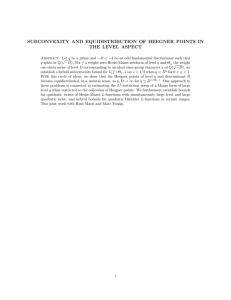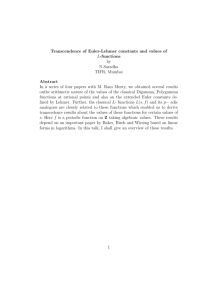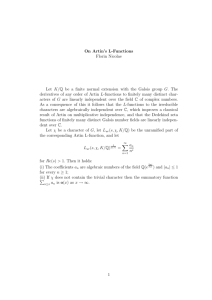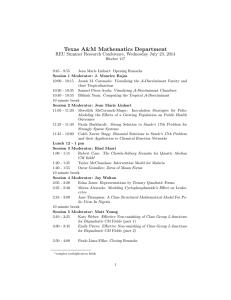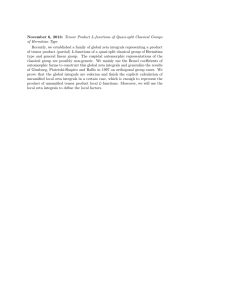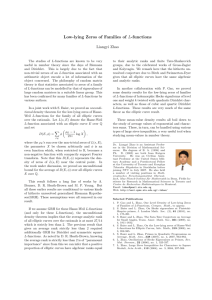Effective Non-vanishing of Class Group L-Functions for Biquadratic CM Fields Katy Weber
advertisement
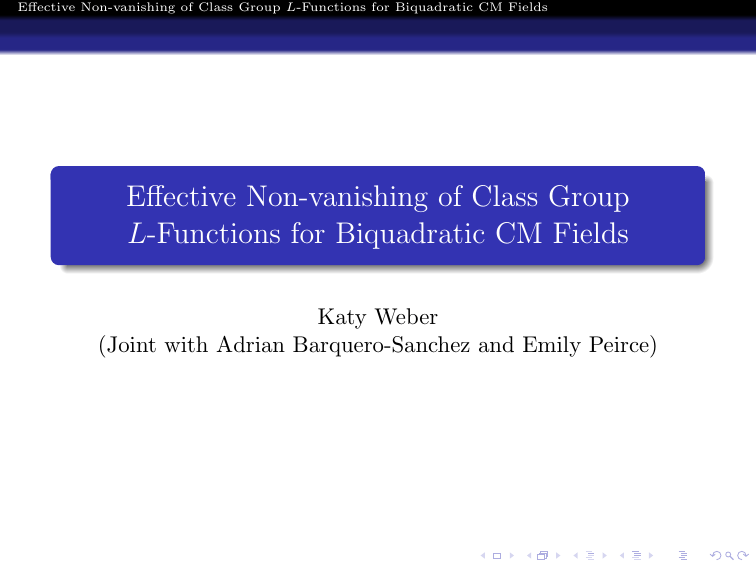
Effective Non-vanishing of Class Group L-Functions for Biquadratic CM Fields
Effective Non-vanishing of Class Group
L-Functions for Biquadratic CM Fields
Katy Weber
(Joint with Adrian Barquero-Sanchez and Emily Peirce)
Effective Non-vanishing of Class Group L-Functions for Biquadratic CM Fields
Notation
Fix the following notation:
F is a number field.
dF is the absolute value of the discriminant of F .
OF is the ring of integers of F .
OF× is the group of units of OF .
Cl(OF ) is the ideal class group of F .
hF is the class number.
RF is the regulator of F .
ζF (s) is the Dedekind zeta function.
γF is the constant term of ζF (s) at s = 1.
Effective Non-vanishing of Class Group L-Functions for Biquadratic CM Fields
The ideal class group
Recall that:
The ideal class group Cl(OF ) is a finite abelian group that
measures “how close” OF is to being a PID.
Effective Non-vanishing of Class Group L-Functions for Biquadratic CM Fields
The ideal class group
Recall that:
The ideal class group Cl(OF ) is a finite abelian group that
measures “how close” OF is to being a PID.
The class number hF is the order of the class group.
Effective Non-vanishing of Class Group L-Functions for Biquadratic CM Fields
The ideal class group
Recall that:
The ideal class group Cl(OF ) is a finite abelian group that
measures “how close” OF is to being a PID.
The class number hF is the order of the class group.
OF is a PID ⇐⇒ F has class number 1.
Effective Non-vanishing of Class Group L-Functions for Biquadratic CM Fields
Group characters
Let G be a finite abelian group.
Effective Non-vanishing of Class Group L-Functions for Biquadratic CM Fields
Group characters
Let G be a finite abelian group.
Definition
A function χ : G → C× is a character of G if it is a group
homomorphism.
Effective Non-vanishing of Class Group L-Functions for Biquadratic CM Fields
Group characters
Let G be a finite abelian group.
Definition
A function χ : G → C× is a character of G if it is a group
homomorphism.
b is a finite abelian group called the group
The set of characters G
of characters of G.
Effective Non-vanishing of Class Group L-Functions for Biquadratic CM Fields
Group characters
Let G be a finite abelian group.
Definition
A function χ : G → C× is a character of G if it is a group
homomorphism.
b is a finite abelian group called the group
The set of characters G
of characters of G.
b = #G.
Note. #G
Effective Non-vanishing of Class Group L-Functions for Biquadratic CM Fields
Class group L-functions
Definition
\
Given χ ∈ Cl(O
F ), we define the class group L-function by
X
L(χ, s) =
χ(C)ζF (s, C)
C∈Cl(OF )
where
ζF (s, C) =
X
06=I∈C
is the partial zeta function.
N (I)−s
Effective Non-vanishing of Class Group L-Functions for Biquadratic CM Fields
Class group L-functions
If χ is nontrivial, L(χ, s) extends to an entire function on
C.
Effective Non-vanishing of Class Group L-Functions for Biquadratic CM Fields
Class group L-functions
If χ is nontrivial, L(χ, s) extends to an entire function on
C.
One has a functional equation relating L(χ, s) to
L(χ, 1 − s).
Effective Non-vanishing of Class Group L-Functions for Biquadratic CM Fields
Class group L-functions
If χ is nontrivial, L(χ, s) extends to an entire function on
C.
One has a functional equation relating L(χ, s) to
L(χ, 1 − s).
The “central value” is L(χ, 12 ).
Effective Non-vanishing of Class Group L-Functions for Biquadratic CM Fields
Class group L-functions
If χ is nontrivial, L(χ, s) extends to an entire function on
C.
One has a functional equation relating L(χ, s) to
L(χ, 1 − s).
The “central value” is L(χ, 12 ).
We wish to determine whether L(χ, 21 ) 6= 0.
Effective Non-vanishing of Class Group L-Functions for Biquadratic CM Fields
Eisenstein series
Let K be a totally real field of degree n with embeddings
σj : K ,→ R for j = 1, . . . , n.
Effective Non-vanishing of Class Group L-Functions for Biquadratic CM Fields
Eisenstein series
Let K be a totally real field of degree n with embeddings
σj : K ,→ R for j = 1, . . . , n.
Let
H = {z ∈ C : Im(z) > 0}
be the complex upper half-plane and z = (z1 , . . . , zn ) ∈ Hn
where zj = xj + iyj ∈ H.
Effective Non-vanishing of Class Group L-Functions for Biquadratic CM Fields
Eisenstein series
Let K be a totally real field of degree n with embeddings
σj : K ,→ R for j = 1, . . . , n.
Let
H = {z ∈ C : Im(z) > 0}
be the complex upper half-plane and z = (z1 , . . . , zn ) ∈ Hn
where zj = xj + iyj ∈ H.
Q
Let y = Im(z) = (y1 , . . . , yn ) and N (y) = nj=1 yj .
Effective Non-vanishing of Class Group L-Functions for Biquadratic CM Fields
Eisenstein series
Let K be a totally real field of degree n with embeddings
σj : K ,→ R for j = 1, . . . , n.
Let
H = {z ∈ C : Im(z) > 0}
be the complex upper half-plane and z = (z1 , . . . , zn ) ∈ Hn
where zj = xj + iyj ∈ H.
Q
Let y = Im(z) = (y1 , . . . , yn ) and N (y) = nj=1 yj .
Q
Let N (α + βz) = nj=1 (σj (α) + σj (β)zj ) for α, β ∈ K.
Effective Non-vanishing of Class Group L-Functions for Biquadratic CM Fields
Eisenstein series
Definition
The Hilbert modular Eisenstein series is defined by
EK (z, s) =
X
2 /O ×
06=(α,β)∈OK
K
N (y)s
,
|N (α + βz)|2s
z ∈ Hn ,
Re(s) > 1.
Effective Non-vanishing of Class Group L-Functions for Biquadratic CM Fields
The average formula
Let E be an imaginary quadratic extension of K (E is called a
CM field ).
Effective Non-vanishing of Class Group L-Functions for Biquadratic CM Fields
The average formula
Let E be an imaginary quadratic extension of K (E is called a
CM field ).
Proposition
For χ ∈ Cl(OE ), we have
1
hE
X
\
χ∈Cl(O
E)
L(χ, s) =
2n dK
√
dE
s
×
[OE
1
× EK (zOE , s),
: OK
]
where zOE ∈ Hn is a certain special point depending on OE .
Effective Non-vanishing of Class Group L-Functions for Biquadratic CM Fields
Statement of Main Result
Theorem (B-S,P,Weber)
Let d1 > 0 and d2 < 0 be squarefree, coprime integers with
√
d1 ≡ 1 mod 4 and d2 ≡ 2 or 3 mod
Assume K = Q( d1 )
√ 4. √
has class number 1 and let E = Q( d1 , d2 ). Then if
np
o
|d2 | ≥ (318310)2 d1 exp
d1 (log(4d1 ) + 2
1
\
then there exists a character χ ∈ Cl(O
E ) such that L(χ, 2 ) 6= 0.


